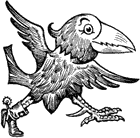 |
Nehemiah's CallP.O. Box 95Broadway, VA 22815540-421-7729 |
|
Eyes to See and Ears to Hear |
||
A Ministry of Prayer and the Word
The ministry of Nehemiah’s Call is a prayer ministry. We are passionate to see revival come to our land here in North America. We are entering into a season of renewed optimism that pending revival through concerted prayer is possible. There are many reports from surrounding communities of a growing sense of God’s special visitation. We see from revival history that this many times is only for a short season. We as a ministry are devoted to teaching the body of Christ eyes to see and ears to hear. Here is a glimpse of something to pray about if you are residing in the state of Kansas.
The Myth of the Jayhawk
There is an unverified story that the Indians believed the great round stones in Rock City in Ottawa county are petrified eggs. The anonymous Indian who made this statement declared they were laid by the Thunderbird. This, he claimed, is the Indian name of the Jayhawk. When asked how any bird known to man could have laid eggs the size of those rocks, some of which are over twelve feet in diameter, his answer was that the Thunderbird, or Jayhawk, not only could change its size at will but could make itself invisible, and was immortal.
This same Indian, who perhaps was invisible himself at the time, declared that the first inhabitants of the great Plains were Jayhawks. They settled here, he explained, because the land was flat. They flew at such a great speed that they needed level runways for landing. When the Jayhawks first came to the plains, he said, all the country was a desert, without water or vegetation, and even without wind. For many moons whenever a Jayhawk wanted a drink he had to fly to the Great Lakes. One hot summer day several million Jayhawks started northeast for water at the same time. The tremendous force of their flight started a strong breeze from the southwest. From that day the wind has never ceased. Since it blew the first clouds across the plains the Indians always credited the Jayhawk with bringing rain and vegetation to Kansas.
The Spaniards of Coronado's day, of course, were the first white men to hear these stories from the Indians. Full of their faith in the existence of cities of gold and the fountain of youth, they not only believed these tales, but eagerly added scientific observations of their own. The following is ascribed to a famous Spanish ornithologist, now unfortunately apocryphal:
"These incredible birds," he says, "we first saw on Sts. Peter and Paul Day as we crossed the river which lies just below Quivira. They were of all sizes, sometimes appearing in great numbers, then of a sudden not to be seen by the keenest eye, so that the men grew apprehensive, saying they made themselves invisible. This they took to be an omen, but whether for good or ill no one could judge.

Jayhawk During Mating Season
(From Apocrypha of Coronado, ca. 1541)
"Now that I wish to describe the appearance of these birds it is to be noticed that no two of our soldiers found it possible to agree in any particular. As it seemed to me, they have a narrow short face, except for the beak, which is long and grotesque, being yellow in color, and curved to a sharp point. The brow of those of the commonest size is two palms across from eye to eye, the eyes sticking out at the side, so that when they are flying they can see in all directions at once. They are blue and red, the feathers shining like the steel of a Toledo sword, iridescent, wherefore it is not possible to say where one color leaves off and another begins. They have long talons, shaped like an eagle's. These claws are so powerful that many of our men, among which even the priest was one, aver that these birds have been seen to fly off with one of those hump-backed cattle in each claw. [He refers to the buffalo.] Some, however, deny this, declaring they have webbed feet. Also there are those who insist, in spite of the laughter of the army, that they have no claws at all but wear great boots extending half way up to the feathers of the leg. And there are some who say they wear but one boot, this being like those worn by horsemen, with a high heel and long spur, most grotesque as they walk about the prairie.
"However this may be," the Spaniard continues, "there is almost general agreement concerning the tail. This is quite short, being a mere tuft of feathers when these birds are in repose. But in flight, or when running along the ground (where they out-distance our best horses) they carry it erect like a scorpion. The Indians say this tail is poisonous, declaring that in battle they employ it as a weapon, flying backwards, which they do with the greatest ease.
"Because of the hoarse voice of this bird, which can be heard one hundred leagues, our soldiers nicknamed it the Feathered Jackass. This disrespect," he naively suspects, "was the cause of all our troubles in this land, the least of which by no means was our failure to locate those golden cities. Inasmuch as we had been warned by the Indians that the Guardian Spirit of the Prairies is none other than this bird, it would have served us better to propitiate it, instead, as our ignorance prompted, to offer them these insults.
"There are some who profess to believe," he concludes, "that these are the birds Aristophanes described in his comedy, which, living between earth and heaven, forced tribute from both men and gods. Wherefrom it is argued that the squawking of these prairie monsters was merely a demand for tribute. Rather do I believe them to be a species of the Phoenix bird, generated in fire and brimstone, and never ceasing do I offer my prayers of thanksgiving to the Virgin, that I was delivered from their country with a whole skin."
This legendary Spaniard was not the last to consider the Phoenix and Jayhawk identical. Like the Jayhawk, the Phoenix is all things to all men, as well as all sizes. It is described as "a bird of gorgeous plumage, a native of Arabia, and sacred to the sun." Some have said the Phoenix is like the roc of Marco Polo and the Arabian Nights, easily capable of making off with a horse. It is most famous, of course, for the fact that it propagates itself in fire, and so makes itself immortal. Phoenix or cuckoo, the Jayhawk continues to be the Guardian Spirit of Kansas.
written by Kirke Mechem
Kansas Historical Quarterlies